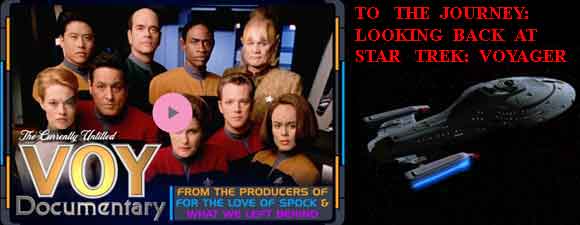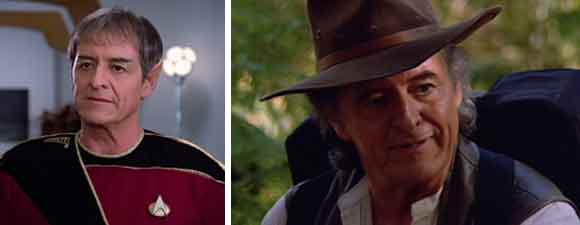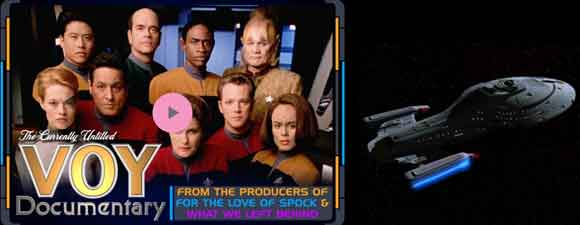Retro Review: Year of Hell, Part II
9 min read
yearofhell2banner
While Janeway tries to stop the Krenim from destroying Voyager, Chakotay learns what drives their leader to change time.
Plot Summary: Voyager hides from the Krenim in a nebula, where deadly gases leak onto the ship, injuring Janeway as she makes repairs. Against the advice of her few remaining officers, she decides to leave the nebula to seek allies. Believing her to be reckless with her own health, the Doctor threatens to take her off duty, and she threatens in turn to deactivate him. In Chakotay’s quarters, Janeway finds the watch he tried to give her. Meanwhile, on the Krenim time ship, Chakotay and Paris are freed from confinement by leader Annorax, who says that he will spare Voyager in exchange for Chakotay’s information about the region. While Chakotay tries to understand and win the trust of Annorax, Paris befriends junior officers who have come to resent centuries of life in space rewriting history. Chakotay learns that Annorax has no intention of stopping until his temporal incursions recover his dead wife, lost in a plague triggered when he erased from history a species with the antibody to the disease. Though Chakotay believes he can convince Annorax to stop destroying other populations, Annorax decides to wipe out another race, thus persuading Chakotay to let Paris try to contact Voyager. Paris is successful, and Janeway puts together an alliance of nearby species, one of whose ships rescues Chakotay and Paris as they confront the Krenim time ship. Annorax damages Voyager beyond repair, so Janeway sets a collision course with his vessel, believing that if she destroys it without using any temporal shielding, all of time may revert to its initial state. After the ships blow up, it is as if the Year of Hell never happened. Voyager receives a warning not to enter Krenim space, which Janeway accepts. Meanwhile, Annorax is interrupted in his work by his wife, who asks him to put aside his temporal meddling and spend the day with her, to which he happily agrees.
Analysis: This is a retro review, meaning that I’m watching it through the lens of the entire series – the episodes that came after it as well as the ones before. Everything I disliked about “The Year of Hell” in the first place is magnified through that lens, particularly in light of the series finale, “Endgame.” This review will contain spoilers for that episode, because everything I disliked about the conclusion – indeed, many of the things I disliked about the final seasons of Voyager – have antecedents in “The Year of Hell, Part II.” The aspects of the main characters’ behavior that troubled me the first time around seem much worse on a rewatch. In my initial review from the night it aired, I wrote, “This is an episode about two crazy captains. One of them is Annorax, leader of the Krenim. The other is Kathryn Janeway of the starship Voyager.” I consoled myself with the belief, based on the conclusion of the two parts of “Year of Hell,” that the story concluded with a statement about how people can change and therefore their fates can change as well. Though it doesn’t make much sense, since Annorax doesn’t remember the centuries of time alteration that failed to improve either his life or the lot of the Krenim, his universe appears to be saved by a single decision: the choice to set aside his calculations and spend an afternoon with the woman whose loss would lay waste to the quadrant. I don’t really understand how Annorax’s new life resets history so precisely for Voyager, since Annorax’s fateful temporal incursion occurred many decades before Voyager entered the Delta Quadrant, so his “Day One” is more than a hundred years before Voyager’s. We never learned why Annorax doesn’t eventually return to the calculations that devastate the Delta Quadrant. Does he die on that happy day with his wife? He fails repeatedly to heed the lesson Kirk taught us all when he let Edith Keeler die in “The City on the Edge of Forever” – that no one life or one planet can be prized about the integrity of the timeline.
Over and over on Star Trek, we’re told that altering the timeline is a far graver wrong than whatever tragedy the alteration is supposed to set right. It’s the equivalent of a classic horror story about bringing the dead back to life – whether it’s Frankenstein, “The Monkey’s Paw” or Pet Sematary, people are always better off leaving bodies in the grave than trying to reanimate them. I’ve always found Deep Space Nine‘s excellent “The Visitor” disturbing because although the circumstances are different – the fact that Sisko keeps reappearing suggests that his initial disappearance may itself represent a rip in the space-time continuum – it dances around the sort of revisionist history that Kirk knows he can’t permit at the Guardian of Forever, that Picard receives a lesson in avoiding in “Tapestry” when his effort to change one small misdeed in his past has repercussions beyond his own life, that Kira resists in “Wrongs Darker Than Death or Night” when she doesn’t use the Orb of Time as a means to assassinate Dukat. The temporal revision in “Year of Hell” is portrayed as no one’s fault – Janeway’s trying to stop Annorax from destroying countless species, Annorax doesn’t even seem aware that a core breach will shatter the timeline – yet that doesn’t make it less troubling, especially in retrospect, because although Janeway ostensibly doesn’t remember anything that happens once the timeline resets, her behavior in “Endgame” seems modeled precisely on that of Annorax; she just gets lucky and achieves her goal on the first try. Because her personal happiness can’t withstand the loss of a single person, in her case Seven of Nine, she will choose to overwrite a timeline in which most of her crew has found happiness and the Federation has prospered. It’s the antithesis of what everyone from Kirk and Spock to Q to Archer has always told us: that even a timeline full of suffering must be maintained unless it is itself a symptom of a rift like the one Worf experiences in “Parallels.”
Is it fair to weigh the full burden of Star Trek’s history against “Year of Hell, Part II”? Maybe timeline issues don’t bother other people as much as they bother me. But there are other trends in the episode that make it problematic, despite some gorgeous visual effects and an unforgettable performance from Kurtwood Smith as Annorax. The reset button ending is such a letdown, a direct copy of Voyager‘s own mediocre “Time and Again” as well as never-mentioned “Year of Hell” prequel “Before and After” in which Kes encounters the Krenim and apparently gets wiped out of Voyager‘s history. It’s pure coincidence that the reset works, because the overworked, isolated captain of Voyager doesn’t understand the first thing about the about the temporal problems. As Annorax explains so that even a child can comprehend it, the ability to alter time makes its linear progression irrelevant. There are always opportunities to start again. Janeway doesn’t have to rush out to confront him – in fact, her haste nearly leads to the premature destruction of her ship before she can stop Annorax. She keeps cheerleader Neelix in her Fave Five while dismissing scientists who might be able to help her succeed. She’s so panicked about losing energy that she wants Chakotay to recycle a gift for her, yet she’s willing to keep the Doctor’s program running just so she can argue with him (using his own little temporal incursion, the mobile emitter from a future century). Unless the Doctor is treating a patient, he should be in the holographic equivalent of standby mode. Of course he’s correct that, like Annorax, Janeway is chasing windmills across the decades in what may very well be a futile effort to get home, but since the pleasure of “Year of Hell” is in watching the confrontation between Captain Ahab and Captain Nemo, what’s the point of having Janeway’s competence questioned at every turn while we’re supposed to be rooting for her?
The rest of the crew is trying so hard. Tuvok tries to take over Chakotay’s role, becoming a shoulder for Janeway to lean on, while Seven tries to take over Tuvok’s role, weighing risks and making logical decisions. Chakotay’s insistence on being a diplomat with Annorax is frustrating because we can see that it’s doomed and leaves Paris, once more, in the role of hero, sticking to Starfleet principles and demonstrating a greater understanding of temporal and mechanical physics than we’ve yet witnessed. I’m still trying to figure out the symbolism of the watch Chakotay tries to give to Janeway, which she initially rejects, then wears as a trophy until the reset button (where presumably it still exists, since Chakotay says he made it months before the Krenim, though we don’t see that version). Is it supposed to represent the linear timeline that Chakotay defends here? Or the connections of affection between people that transcend time, like Annorax’s love for his wife? I really wanted to believe the latter when the episode first aired – that it was, quite simply, a gift of love, which Janeway couldn’t accept at first but which Chakotay’s loss made her understand and come to value above…well, not above the ship, which we’ve just heard her declare to be a member of the crew as important to her as any other. I wish she’d been around to watch Kirk blow up his Enterprise for love of Spock in Star Trek III. Janeway keeps declaring that her crew is a family, but she really doesn’t show it – the choices she makes demonstrate that she only trusts her own judgment and that she sees Voyager as an extension of herself to an unhealthy degree. It’s so frustrating, because she’s so strong – maybe more so than Kirk or Picard, we never saw either with his ship and crew so battered – but she’s wildly inconsistent.
After the reset, Janeway’s decision not to violate Krenim space seems as whimsical as her initial intention to plow through it to get home faster. It’s not taken in consultation with the rest of the senior staff as Picard’s would have been, not weighed carefully behind doors as Kirk would have done with Spock and McCoy. That will be her command style from this point on, until her “Endgame” will involve working with another version of herself, giving orders to crewmembers although many have become her equals, insisting as Annorax does that her version of a perfect universe is the only acceptable version. It’s especially frustrating at the end of “Year of Hell” when we’re shown that the the brutality of Annorax isn’t inevitable – that his future can be altered not by changing the timeline, but through the efforts of people who care about him. There was a time when I believed that to be true of Janeway too, but that’s not the character we see in “Endgame” or in our last glimpse of her in canon, in Star Trek: Nemesis getting two-syllable responses from Picard as she attempts to be friendly while giving dangerous orders. I can’t help it: I still miss Janeway from the first two seasons of Voyager. The captain who comes to the fore in the “Year of Hell” two-parter, unlike Annorax who must be permanently changed, returns with distressing frequency over the course of the series. She isn’t working to restore the timeline for the good of the quadrant or even to reverse the deaths of junior crewmembers. She’s obsessed with the personal goals of getting home and protecting the people who matter most to her at any cost, and yet she can’t even seem to reach out to those people when she needs them.






